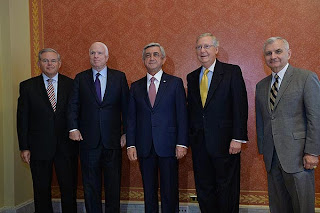
Sargsyan’s Visit to the US Opens New Stage in Bilateral Relations
By Erik Davtyan
On May 6–8, Armenian President Serzh Sargsyan, along with the Minister of Foreign Affairs Edward Nalbandian and Supreme Patriarch and Catholicos of all Armenians Garegin II, paid a working visit to the United States (President.am, May 6). Not counting Sargsyan’s previous visit in September 2014 to attend the 69th session of the United Nations General Assembly, in New York City, this was the Armenian head of state’s first official trip to the US in five years. Sargsyan held a meeting with top US lawmakers, including Mitch McConnell, the Republican Majority Leader of the Senate, and Harry Reid, the Senate’s Democratic Minority Leader. They touched upon the importance of parliamentary cooperation between Armenia and the United States and emphasized US support in the development of Armenia’s economy, civil society and democratic governance. Additionally, President Sargsyan and the senators stressed the US engagement in the Karabakh peace process within the framework of the Organization for Security and Cooperation in Europe’s (OSCE) Minsk Group. On May 6, the Armenian president also had a separate meeting with the US Minsk Group Co-Chair James Warlick (President.am, May 6).
The key result of the working visit, however, was the signing of the bilateral Trade and Investment Framework Agreement (TIFA) by Foreign Minister Edward Nalbandian and Assistant US Trade Representative Daniel Mullaney (Mfa.am, May 7). As Ken Hachikian, the Chairman of the Armenian National Committee of America (ANCA), argued, the bilateral trade and investment agreement promises to improve Armenia’s investment climate, identify priority growth areas, build trade capacity, increase the transparency of governmental processes related to imports and exports, expand agricultural trade and investment, as well as grow the level of trade in services, including banking, insurance and tourism (Armenianweekly.com, May 5). Reportedly, the intensification of US-Armenian trade relations will be coordinated by a special council that will convene at least once a year.
Indeed, this contract will bolster bilateral cooperation and the political dialogue. In the words of ANCA Executive Director Aram Hamparian, the agreement is a “win-win for US-Armenia economic relations” (Armenianweekly.com, May 5). The TIFA should be regarded as the “second wave” of recent US economic engagement in Armenia. Back in 2014, the US company ContourGlobal reached a $250 million deal to purchase the 405-megawatt Vorotan Cascade hydropower project—which is, in fact, the biggest single US investment in Armenia’s energy sphere. Therefore, the newly granted opportunities opened up by the TIFA may prepare the ground for further US economic representation in Armenia, as well as in the wider South Caucasus. Similarly, Armenia will now be in a better condition to reinforce its existing trade turnover with the US as well as diversify its domestic economy. Though Armenia’s membership in the Eurasian Economic Union (EEU) led to the delegation of a part of the country’s economic sovereignty to the EEU’s supra-state bodies, the TIFA will still serve as an impetus for potentially far-reaching perspectives in US-Armenian political and economic relations.
Directly following his working visit to Washington, President Sargsyan flew to Moscow in order to attend a session of the EEU’s Supreme Eurasian Economic Council and the events dedicated to the 70th anniversary of the victory in the Great Patriotic War (President.am, May 8). The fact that the working visit to the US was immediately followed by a trip to Russia served, indeed, as a unique message both to Russia and the United States—and, to some extent, to Europe. Obviously, arriving in Moscow and watching the joint military parade of several national armed forces (including Armenian) with Vladimir Putin and other heads of state shows Armenia’s traditional close ties to Russia. On the other hand, the two-part trip means that despite Yerevan’s membership in the EEU and the seeming imbalance in Armenia’s “East-West” relations, Armenian authorities aspire to develop the “Western direction” of the state’s foreign policy. The signing of a strategic trade agreement with the United States signaled just such an effort.




